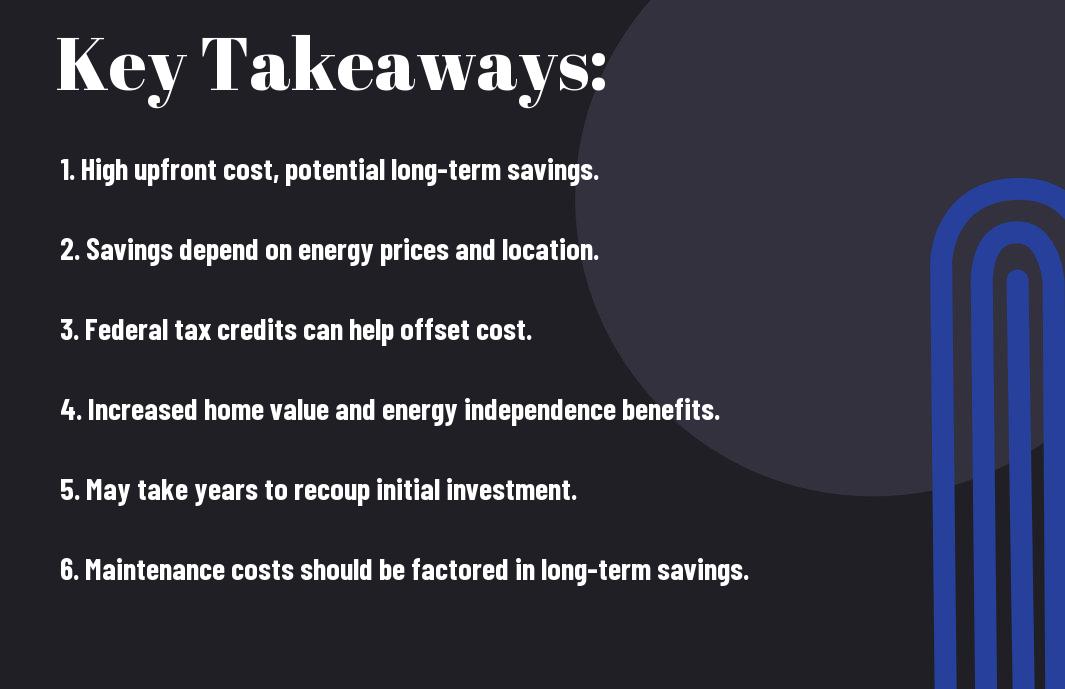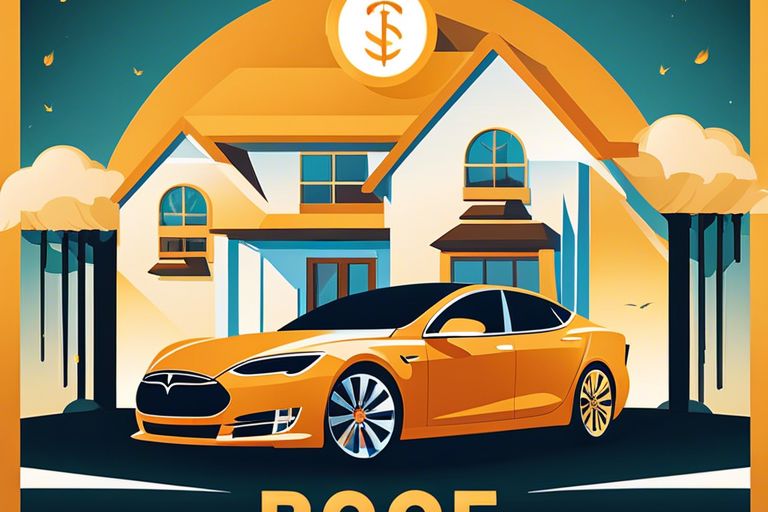You may be considering a Tesla solar roof for your home, but are wondering if the investment will be worth it in the long run. In this informative analysis, we will probe into the details to help you understand whether a Tesla solar roof can indeed pay for itself over time. By examining the costs, savings, and benefits associated with this innovative technology, you will gain valuable insights to make an informed decision about whether a Tesla solar roof is a financially wise choice for you.
Key Takeaways:
- Versatile Energy Production: A Tesla solar roof can generate electricity for your home while also providing protection as a roof, combining functionality and cost-effectiveness.
- Long-term Savings: While the initial cost of a Tesla solar roof may be higher than traditional roofs, it can potentially pay for itself over time through reduced electricity bills and potential tax incentives.
- Increased Home Value: Installing a Tesla solar roof can increase the overall value of your home, making it a worthwhile investment for both financial and environmental reasons.


The Cost of a Tesla Solar Roof
Initial Investment
The initial investment in a Tesla solar roof can vary depending on the size of your home and energy needs. The cost typically ranges from $30,000 to $60,000, including installation. This may seem like a hefty price tag at first, but when you consider the long-term savings on your electricity bill and the potential increase in your home’s resale value, it becomes a more appealing investment.
Ongoing Expenses
An important aspect to consider when evaluating the cost of a Tesla solar roof is the ongoing expenses. While the roof itself requires minimal maintenance, you will still need to account for electricity costs during times when your solar panels are not generating enough power, such as at night. Additionally, you may incur some expenses for cleaning and the occasional maintenance check to ensure optimal performance.
For instance, you may need to factor in the cost of a professional cleaning service or invest in tools and equipment to maintain your solar roof yourself. These ongoing expenses are relatively minimal compared to the potential savings on your electricity bill, but it’s crucial to account for them when calculating the overall cost of owning a Tesla solar roof.
The Benefits of a Tesla Solar Roof
Now, if you’re considering investing in a Tesla Solar Roof, you may be wondering about the overall benefits it can provide. To investigate deeper into the financial aspect, you can check out How Much Does A Tesla Solar Roof Cost In 2024?. Let’s explore some of the key advantages that come with opting for a Tesla Solar Roof.
Renewable Energy Source
Solar energy is not only environmentally friendly but also a sustainable and renewable source of power. By harnessing the sun’s energy through your Tesla Solar Roof, you can reduce your reliance on non-renewable resources and contribute to a greener future.
Energy Savings
When you install a Tesla Solar Roof, you open the door to significant savings on your energy bills. By generating your electricity, you can offset or even eliminate your monthly energy costs, depending on the size of your system and your energy usage.
Savings on energy bills with a Tesla Solar Roof means more money stays in your pocket every month. This can lead to substantial long-term savings over the lifespan of your solar roof.
Increased Property Value
Your roof is not just a protective covering for your home; it’s also a potential asset. A Tesla Solar Roof can enhance the value of your property by offering a modern and eco-friendly feature that appeals to environmentally conscious buyers.
It’s important to note that the increased property value isn’t just about the aesthetics; it’s also about the added functionality and energy efficiency that a Tesla Solar Roof brings to your home. This can make your property more attractive to potential buyers in the future.
How Long Does It Take to Break Even?
Unlike traditional solar panels that are added to your existing roof, a Tesla solar roof is a more significant investment. As a result, the payback period for a Tesla solar roof can vary based on several factors.
Calculating the Payback Period
Take into account the total cost of installing the Tesla solar roof, including any tax incentives or rebates. Then, calculate your average monthly savings on electricity bills after the solar roof is installed. Your payback period is the total cost divided by your monthly savings.
Factors Affecting the Payback Period
On average, a Tesla solar roof can last up to 30 years. However, the payback period can be influenced by factors such as your local sunlight exposure, energy consumption, and any changes in electricity rates.
- Local Sunlight Exposure: If you live in an area with plenty of sunlight, your solar roof can generate more electricity, leading to increased savings.
- Energy Consumption: The more energy you consume, the more significant your savings will be with a Tesla solar roof.
- Electricity Rates: Rising electricity rates can shorten the payback period, making your investment in a solar roof more valuable over time.
Assume that as technology advances and the efficiency of solar panels improves, the payback period for a Tesla solar roof may decrease.
This advanced technology not only provides a renewable energy source but also adds to the overall value of your home, making it an investment that pays for itself over time.

Government Incentives and Rebates
All households can benefit from various government incentives and rebates when installing a Tesla solar roof. These can significantly reduce the overall cost of your solar roof system, making it a more financially attractive option.
Federal Tax Credits
Rebates in the form of federal tax credits are available to you when you opt for a Tesla solar roof. Currently, you can receive a credit for up to 26% of the total cost of your system, including installation. This can lead to substantial savings on your investment and help your solar roof pay for itself over time.
State and Local Incentives
Local governments and states often offer additional incentives for installing solar energy systems like the Tesla solar roof. These incentives can include cash rebates, property tax exemptions, and performance-based incentives. By taking advantage of these programs, you can further enhance the financial benefits of investing in a Tesla solar roof.
Before making your decision, be sure to research the specific incentives available in your area. These additional savings can make a significant difference in the payback period of your Tesla solar roof, bringing you closer to energy independence and long-term cost savings.
Energy Savings and Consumption
Average Energy Consumption
On average, households in the United States consume around 877 kWh of electricity per month. This can vary depending on the size of your home, the number of occupants, and your energy usage habits. Understanding your average energy consumption is crucial in determining the potential savings you can achieve with a Tesla solar roof.
Tesla Solar Roof’s Energy Generation
For every square foot of a Tesla solar roof, you can generate approximately 9-10 watts of power. This means that a standard 2,000 square foot roof could potentially produce enough energy to cover your entire monthly electricity usage. The energy generated by your Tesla solar roof can significantly offset your reliance on traditional grid electricity, leading to substantial cost savings over time.
To maximize the energy generation capabilities of your Tesla solar roof, it is crucial to consider factors such as roof orientation, shading, and local weather patterns. By optimizing these elements, you can ensure that your solar roof operates at peak efficiency, harnessing the maximum amount of solar energy available to power your home.
Comparing Tesla Solar Roof to Traditional Solar Panels
Keep scrolling to compare the Tesla Solar Roof with traditional solar panels based on cost, efficiency, and aesthetics.
Cost Comparison
Comparing the cost of a Tesla Solar Roof to traditional solar panels, you’ll find that the initial investment for a Tesla Solar Roof is typically higher due to its innovative design and integrated technology. However, over time, the lower maintenance costs and potential energy savings could make up for the initial cost difference.
| Tesla Solar Roof | Traditional Solar Panels |
| Higher initial cost | Likely lower initial cost |
| Potential long-term savings | May have higher maintenance costs |
Efficiency Comparison
As far as efficiency, Tesla Solar Roof tiles are designed to seamlessly blend with your existing roof, maximizing the use of available space for solar energy generation. Traditional solar panels, on the other hand, are typically mounted on top of an existing roof, which may not be as aesthetically pleasing and could potentially impact efficiency.
| Tesla Solar Roof | Traditional Solar Panels |
| Integrated design for optimal efficiency | May not be as aesthetically pleasing |
| Maximizes use of available roof space | Mounted on top of existing roof |
With the Tesla Solar Roof, you can expect a more seamless and efficient solar energy solution that complements the design of your home.
Aesthetics and Design
With the Tesla Solar Roof, you get a sleek and modern design that seamlessly integrates with your home’s architecture. The solar cells are disguised as traditional roofing materials, giving your roof a clean and unobtrusive look. This can enhance the overall aesthetics of your home while still serving the purpose of generating renewable energy.
Plus, the Tesla Solar Roof comes in a variety of styles to match different architectural preferences, ensuring that you can find a design that suits your home’s unique look.
To wrap up
Ultimately, whether a Tesla solar roof pays for itself depends on several factors unique to your situation. While the initial cost may be higher than a traditional roof, the long-term savings on your energy bills and potential tax incentives could make it a wise investment in the future. Keep in mind factors such as your home’s energy consumption, local energy rates, and available incentives when deciding if a Tesla solar roof is the right choice for you.
Q: How long does it take for a Tesla solar roof to pay for itself?
A: The payback period for a Tesla solar roof can vary based on factors such as your location, energy usage, available incentives, and the cost of electricity in your area. On average, most homeowners see a return on investment within 6 to 9 years.
Q: Are there any incentives or rebates available for installing a Tesla solar roof?
A: Yes, depending on your location, there may be federal, state, or local incentives available for installing a Tesla solar roof. These incentives can help reduce the upfront cost of the system and shorten the payback period. It’s recommended to check with local authorities or a solar provider to explore potential incentives.
Q: Can a Tesla solar roof increase the value of my home?
A: Yes, installing a Tesla solar roof can increase the value of your home. Studies have shown that homes equipped with solar panels typically sell for higher prices and at a faster rate than those without. A Tesla solar roof not only provides energy savings but also adds to the overall value and appeal of your property.
